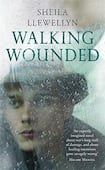
A half-page case history from a 1945 issue of The Lancet medical journal introduces the unforgettable experiment which lies at the core of Sheila Llewellyn's deeply haunted Walking Wounded. The clinical description of a pre-frontal leucotomy performed on a 50-year-old housewife suffering from "melancholia" is reminiscent of Jon Stallworthy's Letter from Berlin where an English doctor witnesses the new vaginal hysterectomy in 1938 Germany. That patient is subsequently revealed to be dead. Silenced forever as the poem links the operation to images from a snow-filled crater at Buchenwald. Walking Wounded's housewife will be silenced too although it's doubtful if her melancholia will be banished and her suffering is linked to the traumatised second World War soldiers who will receive leucotomies, equally doubtful beneficiaries of this experiment.
Daniel Carter, a psychiatrist at Northfield Military Hospital, has worked throughout the war, treating soldiers with psychoanalysis and group therapy. By 1947 he is exhausted, questioning his own role in helping soldiers "recover their poise" so they can go back to situations where they will kill or be killed. Furthermore, he not only witnessed but reluctantly assisted with the operation described in The Lancet. This was performed under local anaesthetic in just under 10 minutes after ECT had been administered to calm the woman's anxiety. Daniel cannot forget, "Those eyes full of terror, full of protest. Then full of nothing. The profound silence when it is all over."
When we first meet the second narrator, soldier David Reece, he is assisting with another operation. Burma, 1943, and a mule is having its vocal cords severed to make it fit for jungle combat. The muleteer sits on its head to keep it still and then retches before coming back to stroke the animal’s long nose, “Poor little bugger. It does everything we do, goes everywhere we go, with more than a hundred and sixty pounds of mortars on its back. Then we do this to it.” The analogy between the beast of burden and the soldier is perfect and shattering, especially when we know that Llewellyn worked as a therapist in Northern Ireland, treating victims of PTSD. The details are from history but the story is current and we’re hearing it from the horse’s mouth.
When David comes to Northfields for treatment, he is lucky to be assigned to Daniel who treats his trauma with therapy and understanding. David’s colleague, Major Hunter, prefers ECT, will go on to perform leucotomies and describes himself “as a doer not a talker”. The troubled relationship between David and Hunter and all that it represents in the wider world of medical research and development forms the core conflict in David’s story.
David's recovery is slow and shaky, mainly assisted by the act of writing down his memories which form a rich part of the narrative. His time before the war working as a messenger boy and a clerk at the Manchester Guardian makes for fascinating reading. There is a great sense of war-time Manchester here too, the streets, cafés and pubs and people. Every place in this novel is haunted by another place, David brings Burma back to Manchester while Manchester was never really far from David's mind when he's serving in the tough Chindit unit in Burma.
Many places converge in the minds of the characters at Northfield Hospital, its “low run of red brick stretching on forever” wonderfully visualised from the beginning when David makes the long climb up the avenue to the building “marooned in a sea of gravel” with its “shark’s tooth” brick border.
As with many memorable novels, the most important journey begins within the walls of a house or institution. The most striking room in Northfields is the “Art Hut” where artist Sergeant Bradbury facilitates – a vivid and moving backdrop to many conversations between the inmates. Art plays a large part in the life of David whose father was an artist, and some of the most beautiful passages in the novel describe the studio of his artist girlfriend.
Llewellyn’s considerable gifts keep us gripped to the end even when the pain described becomes almost unbearable. The beauty and skill of her own writing is the best testament to her belief in the redemptive power of art. Near the end, Daniel remembers his mentor Foulkes complimenting Sergeant Bradbury on his art therapy and Bradbury replies, “There is no such thing as art therapy . . . all art is therapy.”
Martina Evans is a poet and novelist. Her books include ‘Petrol’ and ‘The Windows of Graceland: New and Selected Poems’.

















